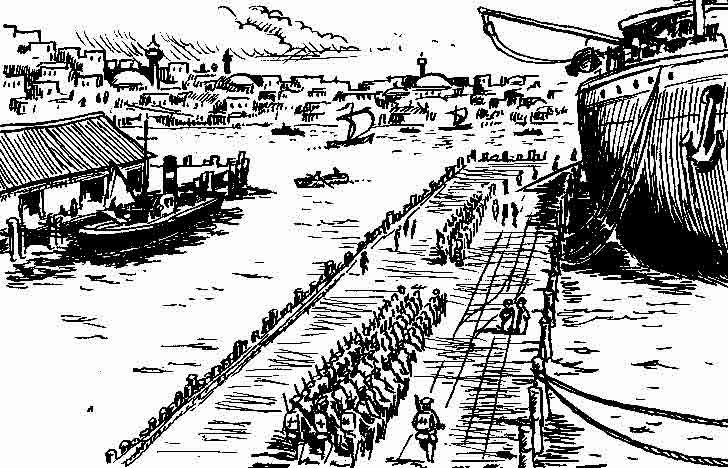Friday, 24 April 2015
Monday, 20 April 2015
The ANZAC Plan
A century ago the ANZACs were preparing to land on the Gallipoli Peninsula, north of Gaba Tepe, while the British and French were planning to land at the mouth of the Dardenelles at Cape Helles and Kum Kale.
They were planning to land on the 23rd of April 1915, as this would give the Covering Force more time to land safely in the darkness between moon set and dawn. The threat of enfilading fire on the landing beach from Gaba Tepe concerned General Birdwood, so this would be mitigated by landing in darkness.
Then on the 20th of April, a strong storm blew in and kicked up the water in Mudros Harbour. It became too dangerous for the the required transfers between the troopships, so the landing was put off.
Now they waited for the wind to die down. With each succeeding day the moon set later and reduced the time of darkness for the landing of the Covering Force. If they waited too long the moon would set after dawn and there would be no chance of surprising the waiting Turks. Birdwood's plan would be ruined. He waited anxiously.
 |
| The British 29th Division was to land at the beaches code named S, V, W, X and Y. |
 |
They were planning to land on the 23rd of April 1915, as this would give the Covering Force more time to land safely in the darkness between moon set and dawn. The threat of enfilading fire on the landing beach from Gaba Tepe concerned General Birdwood, so this would be mitigated by landing in darkness.
Then on the 20th of April, a strong storm blew in and kicked up the water in Mudros Harbour. It became too dangerous for the the required transfers between the troopships, so the landing was put off.
Now they waited for the wind to die down. With each succeeding day the moon set later and reduced the time of darkness for the landing of the Covering Force. If they waited too long the moon would set after dawn and there would be no chance of surprising the waiting Turks. Birdwood's plan would be ruined. He waited anxiously.
Tuesday, 14 April 2015
Preparations for the Anzac Landing
100 years ago - the Allied forces (British and French) gathered in Mudros harbour, Lemnos Island and prepared for the upcoming invasion of the Gallipoli peninsula.
Friday, 3 April 2015
4th April 1915
In Egypt one hundred years ago, on the 4th of
April 1915, the 1st Australian Division and the units of New Zealand
Expeditionary Force who combined to make the Australian and New Zealand Army
Corps (ANZAC) were at this commencing to sail northwards across the Mediterranean
Sea from Alexandria. Their destination was Lemnos Island
 |
| NZ's and Australian's confront the Redcaps at "The Battle of the Wozza" |
The long awaited orders to move to the Front had finally
arrived on the 1st of April. After the “Battle
of the Wozzer” described in an earlier post (here) the soldiers got on with the task of dismantling their tents and
organising their gear for transport to Alexandria .
Piles of kit bags, etc grew beside the road at Mena and Zeitoun. The once busy areas
occupied by these units were now deserted. Arab shopkeepers who had set up
their shops outside the camps (an occurrence still happening today outside our
camps overseas) looked on bewildered, as the respective areas were tidied, emu
bobbed and the rubbish burnt in big pits. The members of the Australian Light Horse and NZ
Mounted Rifles asked enthusiastically when they would be going as well. But all
they got was a shake of the head; for, at this moment, only the infantry brigades
were moving. Men who had been using excuses to exempt themselves from certain
duties (malingering) were seen to be lining up in front of their unit RAP’s in the
hope of being found fit to go with their units. Nobody wanted to miss out on
the adventure, and get away from Egypt.
 |
| Troops embarking at Alexandria. |
Throughout the night and morning of the 3rd of
April as the time for the first few units to move arrived, the men formed up and marched
off to the Cairo
train station. It took four days to move the entire 1st Division
from Mena Camp, leaving only the 3rd Light Horse Brigade, the 4th
Light Horse Regiment, and a few other small units.
The news was splashed across the Cairo newspapers. Security was out the door.
The whole world, including the enemy, soon new that ANZAC was moving. The men
crammed onto troop trains at Cairo and were soon
enroute to Alexandria .
The British and French navies so dominated the Mediterranean
that the ships sailed without an escort.
This proved to be sufficient, for there were not many
instances where the Allied troop movements were threatened. On one occasion however
on the 17 April, as the SS Manitou, carrying
British 29th Division artillery units, was a day out from Lemnos, a
Turkish torpedo boat, the Timur Hissar,
slipped through the “net” and drew alongside. It was a time when chivalry still
existed; a Turkish voice shouted “I’ll give you ten minutes to leave the ship,
then I will sink you.” With that the troops aboard began to hastily man the
life boats.
One boat with sixty men aboard crashed heavily into the sea
smashing itself to pieces and 53 men drowned. As it turned out the Turkish
torpedo boat fired three torpedoes and they all missed, then some British
destroyers arrived and chased it off.
Thus it was that ANZAC was taking the last steps towards its
ultimate fate.
Subscribe to:
Comments (Atom)




















